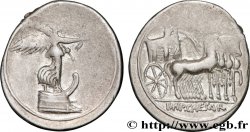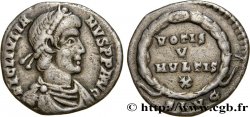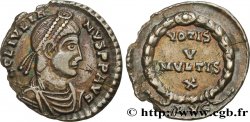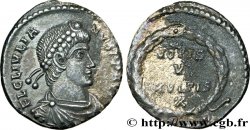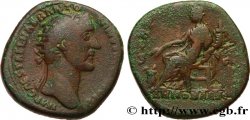E-auction 599-565622 - brm_862877 - OCTAVIAN Quinaire
You must signin and be an approved bidder to bid, LOGIN TO BID. Accounts are subject to approval and the approval process takes place within 48 hours. Do not wait until the day a sale closes to register. Clicking on « bid » constitutes acceptance of the terms of use of cgb.fr private e-auctions.
Bids must be placed in whole Euro amounts only. The sale will start closing at the time stated on the item description; any bids received at the site after the closing time will not be executed. Transmission times may vary and bids could be rejected if you wait until the last second. For further information ckeck the E-auctions F.A.Q.
NO BUYER'S FEE.
NO BUYER'S FEE.
| Estimate : | 150 € |
| Price : | 86 € |
| Maximum bid : | 101 € |
| End of the sale : | 07 October 2024 14:22:40 |
| bidders : | 15 bidders |
Type : Quinaire
Date: 29 AC.
Mint name / Town : Éphèse
Metal : silver
Millesimal fineness : 950 ‰
Diameter : 14,5 mm
Orientation dies : 3 h.
Weight : 1,59 g.
Rarity : R1
Coments on the condition:
Flan un peu court et centré. Bon état général, avec un portrait agréable au droit et un revers détaillé. Usure fine et régulière. Patine grise, des taches plus sombres
Catalogue references :
C.14 (4f.) - RIC.276 - BMC/RE.647 - BN/R.901 - RCV.1568 (400$) - BMC/RR.240 (East) - CRI.429 - RSC.14 - MRK.2 /5
Obverse
Obverse legend : CAESAR - IMP VII.
Obverse description : Tête nue d’Octave à droite (O°).
Obverse translation : “Cæsar Imperator Septimum”, (César revêtu de la septième acclamation impériale).
Reverse
Reverse legend : ASIA - RECEPTA.
Reverse description : Victoria (la Victoire) debout à gauche, tenant une couronne de la main droite et une palme de la gauche, sur la ciste mystique, de laquelle sort de chaque côté un serpent.
Reverse translation : “Asia Recepta”, (L’Asie conquise).
Commentary
L’attribution de ce quinaire est controversée. C. H. V. Sutherland (RIC. 276) le donne à l’atelier de Rome ou de Brindisium frappé entre 29 et 27 avant J.-C. alors que J.-B. Giard le donne à l’atelier d’Éphèse (BN/R., p. 44, pl. XXXV, n° 899) en août 29 avant J.-C. Le style fait néanmoins penser à un atelier oriental.








 Report a mistake
Report a mistake Print the page
Print the page Share my selection
Share my selection Ask a question
Ask a question Consign / sell
Consign / sell
 Full data
Full data

